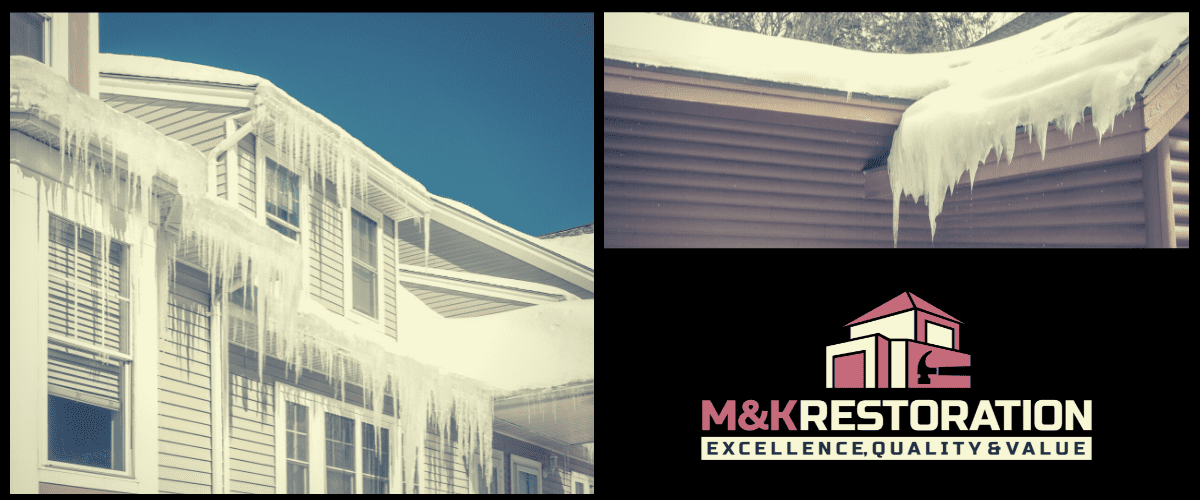
All About Ice Dams
Winter can go one of two ways for you, and it has a lot to do with how much attention you give your roof.
As a roofer in Colorado, we spend a lot of time working around the weather. Dealing with the cold, snow, and ice is a small price to pay for living here. But the weather presents some real challenges for roofers and homeowners alike.
Ignoring your roof during the cold and erratic weather of a Colorado winter can come with some serious consequences. The snow comes down and the snow melts. Rain comes down on top of the snow. Strong winds blow snow every which way. It all melts again.
Your roof protects you from all of these elements. You have to help your roof help you, and it’s just a matter of stopping and thinking about a few little things you need to keep up on.
Ice Dams and Icicles
If you’ve noticed you only have leaks on warmer and/or sunnier days, chances are you might have ice dams.
Ice dams can tear off gutters, loosen shingles, and cause leaks. That can leave you with warped floors, stained walls, saggy ceilings, peeling paint, and even mold or mildew. Ice dams are bad news for homeowners, and they happen more often than you might think.
In many homes, heat collects in the attic and warms the roof– but it doesn’t warm the eaves. Then, accumulated snow melts on the roof and refreezes on the much colder eaves. Ice forms along the eaves and forms a dam. When more ice and snow melts into water, it backs up behind the ice dam and flows under the shingles.
If your home’s ventilation results in a warm attic that causes ice dams, there is one fairly quick and easy fix.
Never hack at ice dams with a shovel, hammer, or chisel. It’s dangerous to you and it could harm your roof and gutters.
Do, however, purchase heat cables at a home improvement store, such as Lowe’s or Home Depot. These heat cables fight against ice dams and equalize your roof’s temperature. Make sure you follow the instructions that come with the cables and use the proper clips and installation patterns.
Also, make sure you install the cables on a clear day and always be safe.
Excessive icicles can also be a sign that you have an ice dam, but they don’t always spell doom. You should, however, always be careful around long icicles. Don’t try to knock them down yourself, or they could hurt you or cause damage to your roof and gutters, especially if they’re part of an ice dam.
Improperly removing icicles can be bad for your home, so make sure you ask a trusted contractor.
Ventilation
You won’t experience any ice dams and resulting leaks if your home is properly ventilated. Ice dams form when your roof becomes too warm for the snow and ice. Proper ventilation, especially roof ventilation, is extremely important all year.
If you think your house may be improperly ventilated, contact your contractor.
Flashing Leaks
On sloped roofs, like most of what we have in Colorado, leaks usually occur along flashing sections. Flashings are the metal pieces that safeguard roof edges, ridges, and corners. It’s found around your roof’s entire perimeter, as well as around your vents, piping, and chimneys.
If your flashing wasn’t properly installed, or if it’s damaged during heavy winds, it can easily pull away from your shingles. That leads to leaks and structural damage.
One of the most effective ways to prevent flashing leaks is with a winter roofing inspection. Compared to the cost of water damage, flashing is exceptionally cheap to replace.
Flashing repairs aren’t normally easy, so we don’t recommend you do it yourself.
Installation and Repair
If you need new shingles installed, a roofer in Colorado will be the first person to tell you winter installation can be challenging. No roofer can effectively install shingles unless it’s at or above 40 degrees. Having direct sunlight to warm the shingles up to a proper ambient temperature, needed for sealing, is even more important.
If it’s below 40 degrees, no one should be installing new shingles on your home. They won’t seal properly, and installing at a colder temperature may void your manufacturer warranty.
Most repairs can be made in cold weather. Flashing can be repaired or replaced, and those leaks stopped even in non-ideal weather conditions. If you have a leak from flashing, an ice dam, or anything else, stop the problem as best you can, and get in touch with a trusted contractor.
The most advisable way to prepare for winter is to find a good contractor who can install your roofing correctly. If your roof is installed correctly and your house is well ventilated, you shouldn’t have any problems at all.
If you’re experiencing leaks or worried about ice dams and ventilation, have an inspection done as soon as you can. Especially considering our weather in Colorado, an inspection will save you plenty of money and heartache in the long run.
Give us a call today for any questions, concerns, or to schedule a free inspection!